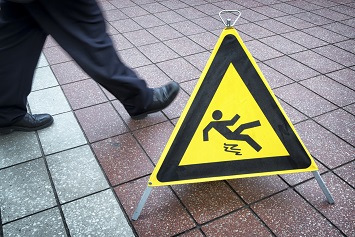In 2017, slips and falls accounted for 887 work-related deaths, making it the second leading cause of work-related death in the United States, according to the National Safety Council’s 2017 Injury Facts®. In general industry, slips, trips, and falls cause the most injuries and comprise 17% of accidental deaths, and in the construction industry, they are the leading cause of accidental death.

So, falls are a major area of emphasis for the Occupational Safety and Health Administration (OSHA). What you do to prevent falls will probably depend upon the type of fall risk your workers are most likely to encounter.
In general industry, the most common type of fall that leads to a recordable injury is a fall on the same level. Here’s how to identify same-level fall hazards and prevent them.
Slipping Hazards
When there’s not enough traction between a worker’s shoe and the walking surface, workers can slip. Hazards that can affect the amount of traction workers are getting include:
Changing walkway surfaces. Whenever the surface changes—from carpet to tile, from asphalt to a metal step—the amount of friction between the worker’s shoe and the floor surface also changes, making a slip more likely.
Solve it: Make sure that changes in the walking surface are well-lit and kept in good condition. For step-ups, like those that workers use to mount a tractor or other large equipment, you can provide handgrips to increase safety.
Wet or oily surfaces. Common problem areas include kitchens, bathrooms, building entrances, and other areas where floors and walkways are often wet or contaminated.
Solve it: Areas that are prone to moisture or greasy contamination, once identified, can be equipped with nonslip flooring and caution signs.
Icy surfaces. This is usually a weather-related, outdoor hazard, but it may also be a problem in walk-in freezers and similar indoor environments.
Solve it: Icy outdoor walkways can be salted and sanded as appropriate. Indoor icy walking surfaces can be equipped with nonslip flooring.
Shifting surfaces. Loose rugs or mats can shift when a worker steps on them, and gravel and some other loose walking surfaces can lead to slippery conditions. In particular, loose gravel and pebbles, finely-divided solids (powder, dirt), or debris (cardboard trash, for example) on a solid walkway surface can cause pedestrians to slip. In 2013, a woman was awarded $725,000 after she slipped and suffered a disabling fall caused by loose pebbles on a public sidewalk.
Solve it: Anchor rugs and mats to prevent slipping. If you use gravel for landscaping or roadway surfaces, make sure to keep it off sidewalks. Keep sidewalks free of potentially slippery powders and dirt, as well.
Inappropriate footwear. Some footwear is more appropriate for the walking surfaces in the workplace than others. For example, if your executives come to tour the factory floor, they should probably swap out their heels and dress shoes for a safer pair of work shoes.
Solve it: Create a work rule in writing that requires everyone in the workplace to wear shoes that are appropriate for the job.
